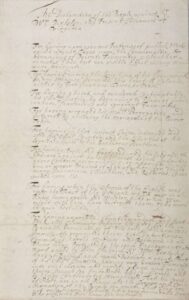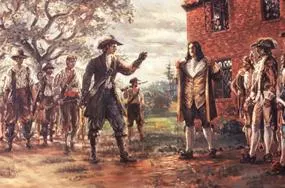by G. Scott Walker
Our study of the 1675-77 time frame of Bacon’s Rebellion brought home the idea that, although we might like a basic, simple solution, a more thorough study of the facts and personalities leads to a variety of conclusions. The Colony had become firmly established after 70 years but was not without problems within (such as conflicts with Native Americans) nor without (the English Civil War). Nonetheless, the Governor, Sir William Berkeley, had been in the colony and in charge since 1642.

By the 1670s, there was continued conflict with the Indians, particularly near the frontier – east of modern Richmond. Tobacco prices had fallen creating more hardship on newer landowners. Into this mix, Nathaniel Bacon arrives. The connected son of well-to-do landowners in Suffolk, England, he is sent to Virginia with a large bankroll and a point of view that does not always agree with the Governor or his ruling class friends. Nonetheless, he is appointed to the Governor’s Council.
By 1675, though, Bacon is at odds with Berkeley over the Governor’s inaction to protect colonists from repeated Indian attacks. A raid into the current Stafford County area is the spark to what is the first rebellion in the English New World. Responding with force, an armed group chases the Indians into Maryland and mistakenly exacts revenge on the wrong tribe: a friendly one. This leads to more and severe raids by the natives and a request by Bacon to lead a group into the fight.
In what can only be a view enabled by our hindsight of almost 350 years, Bacon and Berkeley begin a series back and forth “you can fight” / “you can’t” proclamations by the Governor. At one point, he declares Bacon to be in rebellion but, like the ever changing permissions to fight or not fight the Indians, Berkeley forgives Bacon only to reverse himself again. In ever-mounting conflicts, by September, 1676, Bacon confronts Berkeley at Jamestown and forces the governor to the Eastern Shore. In an astounding act, Bacon burns Jamestown with an order to “lay it flat to the ground.” However, with the governor pressed by the rebels, the entire situation changes with Bacon’s sudden death in Gloucester County from dysentery. His body was buried in a secret grave that has never been found. Without Bacon’s dynamic leadership, the rebellion began too whither.

By the next year, the entire colony west of the Chesapeake Bay is still in revolt against Berkeley. But, at that same time, three Royal Commissioners, a force of armed men, and a small fleet arrive to bolster the governor who is recalled to England by Charles II, Eager to explain himself, the aging governor returns but dies before he can meet with the king. The unrest in Virginia takes another two years to be brought under control and to appease unhappy colonists.
What might we say had transpired. The once popular view of this being the first stirrings of rebellion against British rule 100 years prior to 1776 now seems less probable. In reality, the conflict seems almost personal against Berkeley not the King or the Mother Country. Of course, the actions in this period did not end the Indian Wars. Thirty years later, Governor Alexander Spotswood remarked that there was no answer to this conflict. The choices put governors “between a rock and a hard place”. There never was a correct answer. The harshest result was based this: the charismatic Bacon had followers from every class and race in the colony. His leadership of Black indentured servants, freedmen, and slaves is what alarmed the leadership who then enacted harsher “Slave Laws” to control slaves, changing centuries of British law and customs based on “Primogeniture” (sons inherit) to “Partus Sequitur Vemtrem”, that the basis of slavery or freedom was based on the mother’s status: once a slave, always a slave. This change was monumental in embedding slavery in the American culture and traces its origins to the events in 1676.
Scott Walker is owner of Hallowed Ground Tours in Fredericksburg, Virginia and a former history teacher. He can be reached at tourmaster@hallowedgroundtours.com
